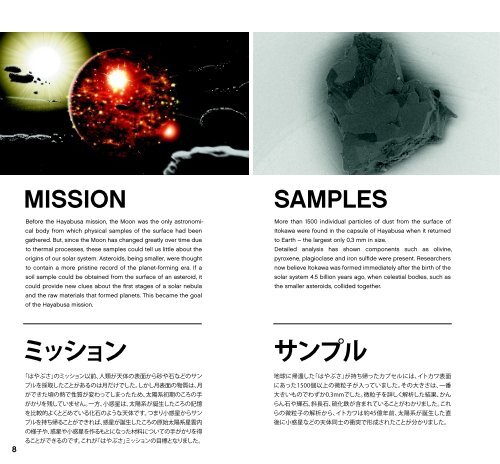Lego Hayabusa - 21101 (2012) - Shinkai 6500 BI 3005/88+4-115+150g GLUED 21101 V46
Lego Hayabusa - 21101 (2012) - Shinkai 6500 BI 3005/88+4-115+150g GLUED 21101 V46
Lego Hayabusa - 21101 (2012) - Shinkai 6500 BI 3005/88+4-115+150g GLUED 21101 V46
You also want an ePaper? Increase the reach of your titles
YUMPU automatically turns print PDFs into web optimized ePapers that Google loves.
MIssION<br />
Before the <strong>Hayabusa</strong> mission, the Moon was the only astronomical<br />
body from which physical samples of the surface had been<br />
gathered. But, since the Moon has changed greatly over time due<br />
to thermal processes, these samples could tell us little about the<br />
origins of our solar system. Asteroids, being smaller, were thought<br />
to contain a more pristine record of the planet-forming era. If a<br />
soil sample could be obtained from the surface of an asteroid, it<br />
could provide new clues about the first stages of a solar nebula<br />
and the raw materials that formed planets. This became the goal<br />
of the <strong>Hayabusa</strong> mission.<br />
sAMPLes<br />
More than 1500 individual particles of dust from the surface of<br />
Itokawa were found in the capsule of <strong>Hayabusa</strong> when it returned<br />
to Earth – the largest only 0,3 mm in size.<br />
Detailed analysis has shown components such as olivine,<br />
pyroxene, plagioclase and iron sulfide were present. Researchers<br />
now believe Itokawa was formed immediately after the birth of the<br />
solar system 4.5 billion years ago, when celestial bodies, such as<br />
the smaller asteroids, collided together.<br />
8
















